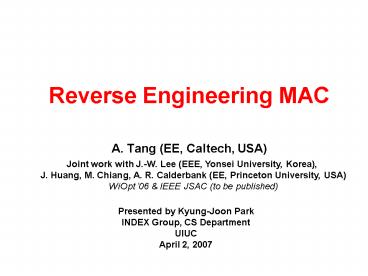Reverse Engineering MAC - PowerPoint PPT Presentation
1 / 16
Title:
Reverse Engineering MAC
Description:
Reverse Engineering MAC. A. Tang (EE, Caltech, USA) Joint work with J.-W. Lee (EEE, ... J. Huang, M. Chiang, A. R. Calderbank (EE, Princeton University, USA) ... – PowerPoint PPT presentation
Number of Views:156
Avg rating:3.0/5.0
Title: Reverse Engineering MAC
1
Reverse Engineering MAC
- A. Tang (EE, Caltech, USA)
- Joint work with J.-W. Lee (EEE, Yonsei
University, Korea), - J. Huang, M. Chiang, A. R. Calderbank (EE,
Princeton University, USA) - WiOpt 06 IEEE JSAC (to be published)
Presented by Kyung-Joon Park INDEX Group, CS
Department UIUC April 2, 2007
2
Reverse Engineering
- Reverse engineering provides
- Understanding properties of individual entity as
well as overall system - Valuable guidance to improve system performance
3
Reverse Engineering
- Reserve engineering in protocol layers
- Layer 4 TCP/AQM Low03
- Layer 3 BGP Griffin02
- Layer 2 MAC (EB protocol based on persistence
probabilities)
- Utility based Reverse Engineering
- What kind of utility functions do users have?
- What kind of optimization problems does the
protocol solve?
4
TCP/AQM Reverse Engineering
- Can be modeled by Network Utility Maximization
(NUM) problem - Utility of each user depends on its own data
rate, which can be directly controlled by user
itself - Feedback from network
- Different TCP/AQM protocols result in different
utility functions
5
MAC Reverse Engineering
- Utility depends on its own transmission and other
links transmissions through collisions - Cannot be controlled by link itself
- No explicit feedback from network
Global optimization model??
Our approach non-cooperative game model
6
System Model
- Persistence probabilistic model
- Link l transmits with probability pl
- If successful, pl plmax for next transmission
- Otherwise, pl maxplmin,?lpl, where 0lt ?l lt 1
- If ?l ½, exactly corresponds to BEB
- Define
- LIto(l) set of links whose transmissions cause
interference to transmission of link l - LIfrom(l) set of links whose transmissions get
interfered from transmission of link l
7
Persistence Probability Update
pl(t1) max plmin, plmax1Tl(t)1 1Cl(t)0
?l pl(t)
1Tl(t)11Cl(t)1 pl(t)1Tl(t)0
(1)
- 1a indicator function of event a
- Tl(t) event that link l transmits at time slot t
- Cl(t) event that there is a collision to link
ls transmission at time slot t
ProbTl(t)1p(t) pl(t) ProbCl(t)1p(t)1-
?n ? LtoI (l)(1-pn(t))
8
EB-MAC Game
- Expected persistence probability
- In (2), each link tries to maximize its utility
Ul for given strategies of other links - Define EB-MAC game as
- E set of players (links)
- Al pl plmin ? pl ? plmax action set of
link l - Ul utility function of link l
pl(t1) max plmin,plmax pl(t) ?n ?
LtoI(l)(1-pn(t)) ?l pl(t) pl(t) (1-
?n ? LtoI(l)(1-pn(t))) pl(t) (1-pl(t)) (2)
GEB-MAC E, ?l ? E Al, Ull ? E
9
EB-MAC Game
- Theorem 1 Utility function is expected net
reward (expected reward minus expected cost) that
link can obtain from its transmission - where
- Furthermore, there exits a Nash equilibrium
characterized by
Ul(p)R(pl) S(p) - C(pl) F(p) ? l
S(p) pl ?n ? LtoI(l)(1-pn) probability of
transmission success
F(p) pl (1- ?n ? LtoI(l)(1-pn)) probability
of transmission failure
R(pl) pl(1/2plmax 1/3 pl) reward for
transmission success
C(pl) 1/3 (1- ?l) pl2 cost for transmission
failure
10
EB protocol as a stochastic subgradient algorithm
- Theorem 2 The EB protocol described by (1) is a
stochastic subgradient algorithm to maximize
utility functon Ul
11
Uniqueness and Convergence of Nash Equilibrium
- Define best response function as
- Assume that
- all links have same pmax and pmin
- pmax lt 1 and pmin 0
- Theorem If , then
- Nash equilibrium is unique
- From any initial point, iteration by best
response converges to unique equilibrium - where K maxlLtoI(l)
pl(t1) argmaxplmin ? pl ? plmax Ul(pl,p-l(t))
12
Stochastic Subgradient vs. Best Response
- Define a new update algorithm for link l as
- vl(t) stochastic subgradient
- ?l(t) step size
- Theorem 6 The updates above converge to best
response solution of user l under fixed p-l with
probability 1 if all the following conditions
hold - Step size ?(t) satisfies ?(t) ? 0, ?t0??(t)
?, ? t0??2(t) lt?, e.g., ?(t)1/t - Modified minimum persistent probability
plminpmax( 1-pmin)Ml/1-?(1-( 1-pmin)Ml? pmin - Values of pmin, pmax and ? satisfy
(1-?)/?(1/(1pmax)Ml-2/(1-pmin)Ml)?1, where
MlLtoI(l) is the number of interfering links
with link l
pl( t1) maxplmin,min plmax,pl(t) ?l(t)
vl(t)
13
Stochastic Subgradient vs. Best Response
The minimum value of ? that satisfies condition 3
of Theorem 6 vs. the number of interfering links
Ml with an infrared physical layer in 802.11
14
Numerical Results
Figure 1. A network with six links
15
Numerical Results of Link 1
Comparison of trajectories of pl(t) in the
network in Figure 1
16
Conclusion and Future Work
- Reverse engineering for EB MAC protocol
- Non-cooperative game model
- Each link tries to maximize its utility in form
of net reward for successful transmission using
stochastic subgradient algorithm - Nash equilibria exist but, in general, no
guarantee for uniqueness and convergence - showed conditions for uniqueness and convergence
- Future work
- Efficiency loss analysis
- Reverse engineering CSMA/CA
- Stochastic effects such as arrival statistics































